This last November, I invited Rokslide’s Matt Cashell to the Rok Blog to demonstrate his testing on the new Berger Classic Hunter Bullet. Rok Blog subscribers also had a chance to win a box of the Classic Hunters (hint, hint). If you missed that post, see Testing Berger’s New Classic Hunter Bullet.
Matt is back with his final installment on the Classic Hunters. He spent a fall hunting multiple species and has a complete terminal performance report for us. I’ve also paired up with Berger Bullets to make sure three Rok Blog subscribers get a box of the new Classic Hunters. Take it away Matt.
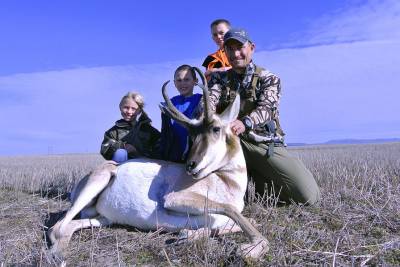
Part one of my Berger Classic Hunter test demonstrated the bullet’s easy-to-load and accurate design. Yet the question remained: What is the terminal performance? Terminal performance refers to what the bullet does to the animal upon impact. In the case of a hunting bullet, the goal is a quick and clean kill. In order to have good terminal performance a bullet needs to be able to penetrate to the vital organs, and then sufficiently damage the vital tissue to result in a quick kill.
With tags in my pocket, I ventured into the prairies and mountains of Montana to find out. My first opportunity came on the windswept flat country of north-central MT. I had the kids along, as antelope hunting is a great family hunt with frequent stalks and a warm truck never too far away.
After a couple of nearly successful stalks with my oldest in tow, I found myself belly down on the stubble watching some black horns bobbing their way towards me over a low rise. I ranged the buck at around 400 yards, but do to the extremely flat terrain, he cut the distance to 260 yards before he offered a head-on throat patch shot. I put the crosshairs right on the white throat patch. It was easy to be confident with the impressive accuracy the Classic Hunters had shown me in load development.
BOOM … WHOP. The sound of the hit came back and I could see legs in the air. I approached the buck and found a tiny entrance hole and large exit wound several inches wide out the back of the neck. The small entrance wound was difficult to find. The bullet penetrated almost three inches before fragmenting, where it plowed a large wound channel. The channel damaged some neck meat and a portion of one backstrap. I would have preferred to place the shot a little higher and have the wound channel go into the air above the back, or lower and have the channel penetrate into the chest cavity.
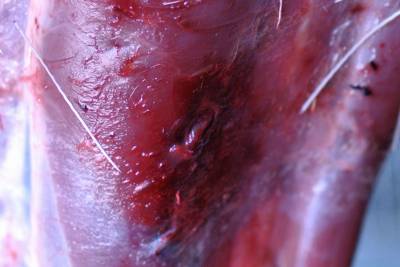
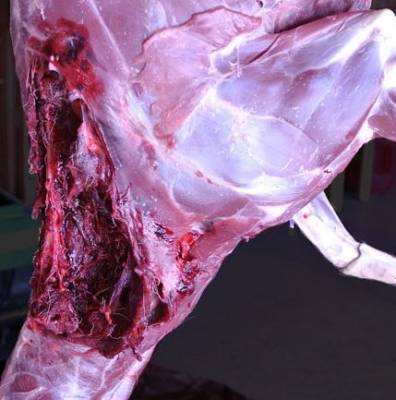
Tiny entrance hole Classic Hunter’s devastating wound channel
Fast forward to November and I was hunting elk in the late season snow. We had ridden horseback into a wilderness area in Western MT and tracked a herd of about 40 cows and calves to the border of the hunting district. We sneaked to a shooting position across the drainage from the herd. I set up and picked out a fat cow at 311 yards and waited. Soon she fed into a shooting lane. I rested my crosshairs high on the shoulder, hoping to keep her from running to the neighboring district. In a millisecond, I heard the reassuring sound of a hit echoing behind the report of the Savage. The cow tried to run up the hill with the herd at the shot, but she only made it a few leaps before sliding down the snowy slope, leaving a bright crimson trail.
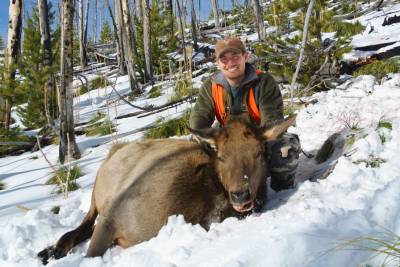
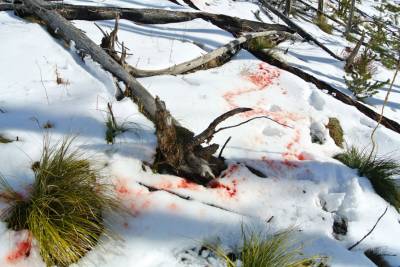
Upon inspection, the bullet penetrated the on-side scapula, leaving a neat caliber-sized hole in the bone. The bullet then fragmented violently, with the wound channel destroying the lung tissue before leaving an exit wound through the ribs on the far side. Loops of streaming blood spread across the snow.
Meat damage was very little around the tiny entrance hole. There was some bloodshot meat around the exit, including some in the off-side shoulder from bullet fragments. There was quite a bit of blood that collected between the hide and the ribs. Initially I thought this was additional bloodshot meat, but after de-boning it was apparent that much of the bleeding occurred in the connective tissues on top of the meat, and not within the meat itself.
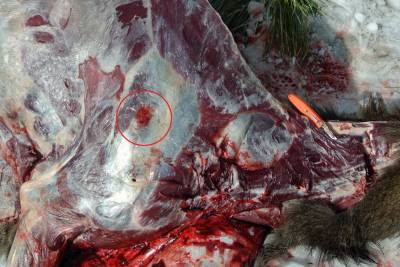
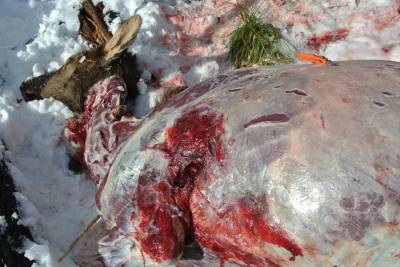
Classic Hunter entrance side Exit side
Two kills is obviously not a large sample size, but the bullets performed very similarly on two very different targets and angles. This performance is very similar to kills I have had with Berger Hunting VLD bullets, the predecessor to the Classic Hunter design. That is, the bullets maintain their structural integrity for several inches upon impact before expanding violently and causes massive tissue damage in a large wound channel, resulting in quick kills. Depending on shot placement, there is some cost in lost meat if this wound channel passes through an area of quality cuts. On broadside targets, the bulk of the damage is inflicted on the vital organs. Considering this effective killing performance with their awesome accuracy, exterior ballistic performance, and easy loading, I think Berger has a real winner in the Berger Classic Hunter.
____________________________________________________________________________________________________________________________
Thanks Matt, great post.
So Rok Blog subscribers, the generous folks at Berger Bullets ponied up not one, not two, but three boxes of Classic Hunters for me to giveaway to three seperate winners! The odds of winning will be great. If you’d like to get a box of Berger Classic Hunters in the caliber of your choice, just take the next four steps for a chance to win:
1) If you’re not already a Rok Blog subscriber (be sure), go to top of page under Fitness/Other links, right hand side, and click “Subscribe to blog”
2) Go to the Berger Bullet Facebook page and “Like” the Berger Bullet page (top of page under banner) AND “Like” the post about this giveaway
3) “Like” the Rokslide Facebook page (top of page under banner) AND “Like” the this post about this giveaway
4) Finally, post up in the Rok Blog comments section below the caliber you’d choose and what rifle you’ll be shooting (use first and last name).
You have to complete all four steps to win. Trust me, many people rush through the entry process, miss steps, and aren’t eligible to win. So pay attention!
I’ll conduct the drawing on Tuesday, April 8th. Watch your email for winner notification. Due to popular demand and caliber choice, there may be a significant delay in shipping your bullets.

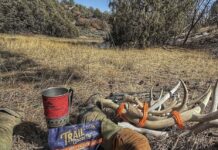
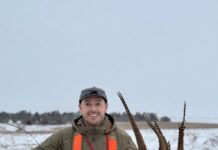



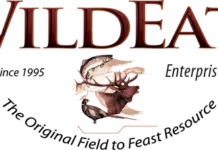
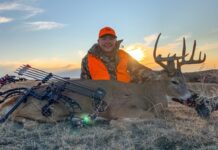





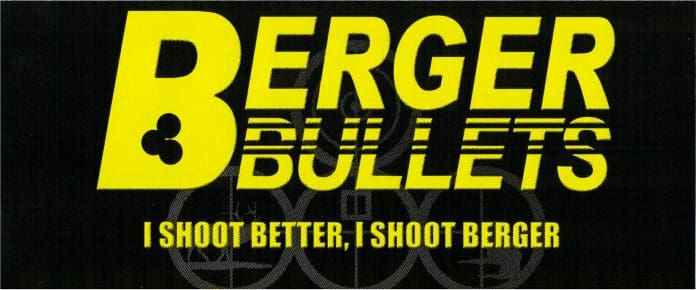



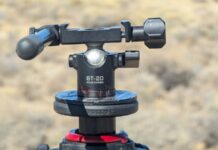



Great review Matt! I’d want .30 cal for my Remington BDL 30.06.
Thanks for another great giveaway!
Caliber, .338 Winchester Magnum
Rifle: Winchester Model 70 Classic
Thanks for the review. Have to go with .30 cal for my Defensive Edge LWLR .300 RUM.
Sorry I don’t do Facebook but if I’m still eligible I will put it here anyway.
.25 caliber for me driven from a .257 Weatherby, Remington 700LSS.
Nice review, keep up the excellent stuff
ruger m77 .270. thanks for the reveiw Matt.
Great review. I would go with .270 cal for my Winchester Ranger. Love this blog, thanks guys!
and the Rok Blog loves you guys!
115 gr. VLD for my 257 WBY Remington 700 LSS. These bullets are incredible! Buck the wind really well vs. most 25 caliber projectiles.
It would be great to work with Berger’s in my 7mm WSM Model 70 project!
All of my rifles shoot Berger bullets.A only Berger bullets.If you will try these you will never stop.They are bad news to Mr. Whitetail.
7mm through my Savage 114 American Classic!
Thanks for the review Matt. I am trying to tune my 300 win mag in and the bergers have been the best yet.
Thanks Matt. I would love to use these in my Ruger M77 stainless 300 win mag.
Nice review. 7mm 168 gr. in a sako a7 big game
300 Saum, would love some to use. Bergers are the best for LR.
Eric, I had a Sako A5 in 7mm. Great shooting rifle. Make sure you post up your last name or I can’t find you on the draw list if I pull your number.
Thanks
Nice review I’m looking for a new hunting bullet and these might be the ticket (especially if they are free). I will be shooting a Remington 700 XCR in 300 wim mag so I would like 30 cal bullets please.
243 or 7mm.
.277 130 GR. for my Sako A7 270 WSM or 30 Cal. (.308) for my Rifles Inc. 300 Win Mag Strata!
Thanks,
Daniel Partridge
Great Review. I’m slowly gaining more confidence in Bergers. At first I didn’t like the idea of a bullet not exiting the animal. .264 cal for a 260 Remington
Thanks again for the opportunity Robby. I would love to try these in my 300 WSM…
Darin
Great review. I would be using these bullets in my sons 243 savage axis. Thanks for the giveaway!
Rick Ulibarri
6.5×284 Savage long range hunter. Thanks
Eric Schoenfelder aka gethuntin
Hey Great review, but you didn’t mention the load you used. I assume it is the 168 Classic Hunter you did the accuracy test in the previous article? In a 7mm Rem Mag?
Dave
Dave, yes, that was the 168 grain 7mm Hunter Classic he used in both tests. I’m shooting them now (range only) and so far they are shooting very well and flatter than the other bullets I’ve tried in the 160-175 grain range. I’ll have a review up this winter some time.
Comments are closed.